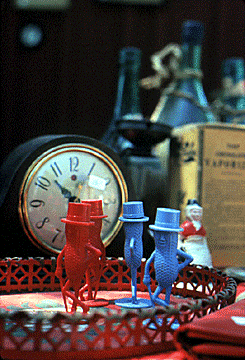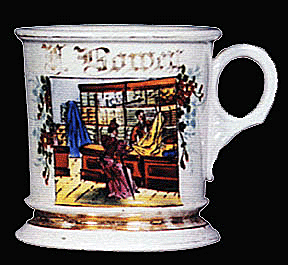Antiques or Junk?
by
Bob Brooke
 In
today's modern world, you may describe just about anything that’s old
as an antique and in generic terms that’s true. In reality, antiques
are products that are more than 100 years old or products that are rare
enough to have some value. In other words, antiques are old items that
are in limited supply. The more limited, the more antique the item. In
today's modern world, you may describe just about anything that’s old
as an antique and in generic terms that’s true. In reality, antiques
are products that are more than 100 years old or products that are rare
enough to have some value. In other words, antiques are old items that
are in limited supply. The more limited, the more antique the item.
Another way to think of
antiques is as something collectible. Whether the item is a piece of
furniture you want to collect to enhance the look of a room, a ceramic
piece to decorate a corner cupboard, or some silverware you want to hand
down to your grandchildren, the items must be rare enough to be
considered antiques. Everything else is secondhand goods or junk.
One misconception people
have about antiques is that the older they look, the more antique they
must be. Wrong! Appearance has nothing to do with it. Just because a
piece looks like it came out of grandma's attic doesn’t mean it’s an
antique–even though grandma might be. Not in the true sense of the
word. If no one wants it, no matter how old it looks, it's just a piece
of junk. Antiques have value, and that value is based on demand due to
suitability and limited supply.
 Most people become
interested in antiques for one of two reasons: They either have an
interest in collecting a particular type of antique purely for personal
enjoyment–ceramics or pottery are the most common, or they inherit
some items from a family member. But everyone wants to be sure of one
thing—that what they buy or inherit will appreciate in value. That's
what antiques are all about, isn't it? All those stories about people
who buy some piece of junk at a garage sale that turns out to be a
valuable antique worth thousands of dollars are really true, aren't
they? And if they can do it, why can't you? Most people become
interested in antiques for one of two reasons: They either have an
interest in collecting a particular type of antique purely for personal
enjoyment–ceramics or pottery are the most common, or they inherit
some items from a family member. But everyone wants to be sure of one
thing—that what they buy or inherit will appreciate in value. That's
what antiques are all about, isn't it? All those stories about people
who buy some piece of junk at a garage sale that turns out to be a
valuable antique worth thousands of dollars are really true, aren't
they? And if they can do it, why can't you?
But before you get your
hopes up, you need to know something about what you have. Two principles
apply when collecting antiques: Know everything you can about the
antiques that interest you and obtain them at the lowest possible price.
By doing so you will not only get maximum enjoyment out of owning the
antique, but you'll also be sure that your investment appreciates in
value.
 Many people, however,
inherit an item or a whole house full of antiques from a relative. Just
as many of those who do never had an interest in antiques until their
great aunt left them with a bundle of them. Then the dollar signs start
to appear. What most don’t consider is that much of what Great Auntie
had is probably just junk, unless she was a seasoned collector and knew
what she had. True, people could have bought furniture to decorate their
homes a long time ago and that furniture, if it was of fine quality when
new, would now be worth something. Many people, however,
inherit an item or a whole house full of antiques from a relative. Just
as many of those who do never had an interest in antiques until their
great aunt left them with a bundle of them. Then the dollar signs start
to appear. What most don’t consider is that much of what Great Auntie
had is probably just junk, unless she was a seasoned collector and knew
what she had. True, people could have bought furniture to decorate their
homes a long time ago and that furniture, if it was of fine quality when
new, would now be worth something.
 But only a professional
appraiser can tell you that. And appraising costs money–something like
$100-150 an hour. So before you ask someone how much an item is worth,
be prepared to shell out a few bucks for the information. The reason
appraisers charge so much is that they do most of their work for
insurance companies and lawyers settling estates. Appraising isn’t an
exact science, but it requires an appraiser to do lots of research and
then prepare a detailed report that’s accepted in a court of law. But only a professional
appraiser can tell you that. And appraising costs money–something like
$100-150 an hour. So before you ask someone how much an item is worth,
be prepared to shell out a few bucks for the information. The reason
appraisers charge so much is that they do most of their work for
insurance companies and lawyers settling estates. Appraising isn’t an
exact science, but it requires an appraiser to do lots of research and
then prepare a detailed report that’s accepted in a court of law.
So how do you do know if
an item is an antique? By learning as much as possible about the
antiques you want to collect or have inherited. Libraries and bookstores
aren't much help. Row upon row of books cover every conceivable antique
in the greatest detail. Books on pottery, glassware, antique dolls and
even movie memorabilia fill shelves as far as the eye can see. Not to
mention the price guides: There are enough of them to sink a ship. Just
to get a simple overall understanding of antique collecting you're going
to have to spend a fortune at your favorite bookstore or spend every
free evening browsing your favorite bookstore's shelves.
To read
more of my articles, please
visit
my Web site.
< Back to
Antiques Articles
Next Article >
|
